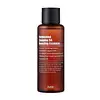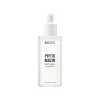What's inside
What's inside
 Key Ingredients
Key Ingredients

 Benefits
Benefits

 Concerns
Concerns

No concerns
 Ingredients Side-by-side
Ingredients Side-by-side

Butylene Glycol
HumectantCamellia Sinensis Leaf Extract
AntimicrobialTaraxacum Platycarpum Extract
Skin ConditioningLactobacillus/Rice Ferment
Skin ConditioningMorus Alba Bark Extract
Skin ConditioningNiacinamide
Smoothing1,2-Hexanediol
Skin ConditioningWater
Skin ConditioningAcrylates/C10-30 Alkyl Acrylate Crosspolymer
Emulsion StabilisingCaprylyl Glycol
EmollientAllantoin
Skin ConditioningArginine
MaskingAdenosine
Skin ConditioningDisodium EDTA
Dipotassium Glycyrrhizate
HumectantPortulaca Oleracea Extract
Skin ConditioningGlycerin
HumectantPerilla Ocymoides Seed Extract
AntioxidantSodium Hyaluronate
HumectantNelumbo Nucifera Flower Extract
Skin ConditioningButylene Glycol, Camellia Sinensis Leaf Extract, Taraxacum Platycarpum Extract, Lactobacillus/Rice Ferment, Morus Alba Bark Extract, Niacinamide, 1,2-Hexanediol, Water, Acrylates/C10-30 Alkyl Acrylate Crosspolymer, Caprylyl Glycol, Allantoin, Arginine, Adenosine, Disodium EDTA, Dipotassium Glycyrrhizate, Portulaca Oleracea Extract, Glycerin, Perilla Ocymoides Seed Extract, Sodium Hyaluronate, Nelumbo Nucifera Flower Extract
Niacinamide
SmoothingLeontopodium Alpinum Extract
Skin ConditioningGentiana Lutea Root Extract
Skin ConditioningPotassium Sorbate
PreservativeAlcohol
AntimicrobialRosa Canina Fruit Extract
AstringentArnica Montana Flower Extract
MaskingSodium Benzoate
MaskingGlycerin
HumectantBambusa Vulgaris Extract
Skin ConditioningAchillea Millefolium Extract
CleansingAcrylates/C10-30 Alkyl Acrylate Crosspolymer
Emulsion StabilisingPotassium Hydroxide
BufferingMorus Alba Bark Extract
Skin ConditioningNelumbo Nucifera Flower Extract
Skin ConditioningButylene Glycol
HumectantArtemisia Absinthium Extract
Skin Conditioning1,2-Hexanediol
Skin ConditioningCitrus Limon Fruit Extract
MaskingSodium Hyaluronate
HumectantDisodium EDTA
Citric Acid
Buffering3-O-Ethyl Ascorbic Acid
Skin ConditioningNiacinamide, Leontopodium Alpinum Extract, Gentiana Lutea Root Extract, Potassium Sorbate, Alcohol, Rosa Canina Fruit Extract, Arnica Montana Flower Extract, Sodium Benzoate, Glycerin, Bambusa Vulgaris Extract, Achillea Millefolium Extract, Acrylates/C10-30 Alkyl Acrylate Crosspolymer, Potassium Hydroxide, Morus Alba Bark Extract, Nelumbo Nucifera Flower Extract, Butylene Glycol, Artemisia Absinthium Extract, 1,2-Hexanediol, Citrus Limon Fruit Extract, Sodium Hyaluronate, Disodium EDTA, Citric Acid, 3-O-Ethyl Ascorbic Acid
 Reviews
Reviews

Ingredients Explained
These ingredients are found in both products.
Ingredients higher up in an ingredient list are typically present in a larger amount.
1,2-Hexanediol is a synthetic liquid and another multi-functional powerhouse.
It is a:
- Humectant, drawing moisture into the skin
- Emollient, helping to soften skin
- Solvent, dispersing and stabilizing formulas
- Preservative booster, enhancing the antimicrobial activity of other preservatives
Acrylates/C10-30 Alkyl Acrylate Crosspolymer is a synthetic polymer. It is used to thicken and improve the texture of products. Due to its properties, it can prevent water and oil ingredients from separating.
Butylene Glycol (or BG) is used within cosmetic products for a few different reasons:
Overall, Butylene Glycol is a safe and well-rounded ingredient that works well with other ingredients.
Though this ingredient works well with most skin types, some people with sensitive skin may experience a reaction such as allergic rashes, closed comedones, or itchiness.
Learn more about Butylene GlycolDisodium EDTA plays a role in making products more stable by aiding other preservatives.
It is a chelating agent, meaning it neutralizes metal ions that may be found in a product.
Disodium EDTA is a salt of edetic acid and is found to be safe in cosmetic ingredients.
Learn more about Disodium EDTAGlycerin is already naturally found in your skin. It helps moisturize and protect your skin.
A study from 2016 found glycerin to be more effective as a humectant than AHAs and hyaluronic acid.
As a humectant, it helps the skin stay hydrated by pulling moisture to your skin. The low molecular weight of glycerin allows it to pull moisture into the deeper layers of your skin.
Hydrated skin improves your skin barrier; Your skin barrier helps protect against irritants and bacteria.
Glycerin has also been found to have antimicrobial and antiviral properties. Due to these properties, glycerin is often used in wound and burn treatments.
In cosmetics, glycerin is usually derived from plants such as soybean or palm. However, it can also be sourced from animals, such as tallow or animal fat.
This ingredient is organic, colorless, odorless, and non-toxic.
Glycerin is the name for this ingredient in American English. British English uses Glycerol/Glycerine.
Learn more about GlycerinWe don't have a description for Morus Alba Bark Extract yet.
Nelumbium Speciosum Flower Extract comes from the Lotus Flower. It is rich in antioxidants.
The antioxidant properties in lotus flower come from compounds such as flavonoids.
In traditional Asian medicine, Lotus flower seeds were used to help treat inflammation.
Learn more about Nelumbo Nucifera Flower ExtractNiacinamide is a multitasking form of vitamin B3 that strengthens the skin barrier, reduces pores and dark spots, regulates oil, and improves signs of aging.
And the best part? It's gentle and well-tolerated by most skin types, including sensitive and reactive skin.
You might have heard of "niacin flush", or the reddening of skin that causes itchiness. Niacinamide has not been found to cause this.
In very rare cases, some individuals may not be able to tolerate niacinamide at all or experience an allergic reaction to it.
If you are experiencing flaking, irritation, and dryness with this ingredient, be sure to double check all your products as this ingredient can be found in all categories of skincare.
When incorporating niacinamide into your routine, look out for concentration amounts. Typically, 5% niacinamide provides benefits such as fading dark spots. However, if you have sensitive skin, it is better to begin with a smaller concentration.
When you apply niacinamide to your skin, your body converts it into nicotinamide adenine dinucleotide (NAD). NAD is an essential coenzyme that is already found in your cells as "fuel" and powers countless biological processes.
In your skin, NAD helps repair cell damage, produce new healthy cells, support collagen production, strengthen the skin barrier, and fight environmental stressors (like UV and pollution).
Our natural NAD levels start to decline with age, leading to slower skin repair, visible aging, and a weaker skin barrier. By providing your skin niacinamide, you're recharging your skin's NAD levels. This leads to stronger, healthier, and younger looking skin.
Another name for vitamin B3 is nicotinamide. This vitamin is water-soluble and our bodies don't store it. We obtain Vitamin B3 from either food or skincare. Meat, fish, wheat, yeast, and leafy greens contain vitamin B3.
The type of niacinamide used in skincare is synthetically created.
Learn more about NiacinamideSodium Hyaluronate is hyaluronic acid's salt form. It is commonly derived from the sodium salt of hyaluronic acid.
Like hyaluronic acid, it is great at holding water and acts as a humectant. This makes it a great skin hydrating ingredient.
Sodium Hyaluronate is naturally occurring in our bodies and is mostly found in eye fluid and joints.
These are some other common types of Hyaluronic Acid:
Learn more about Sodium Hyaluronate